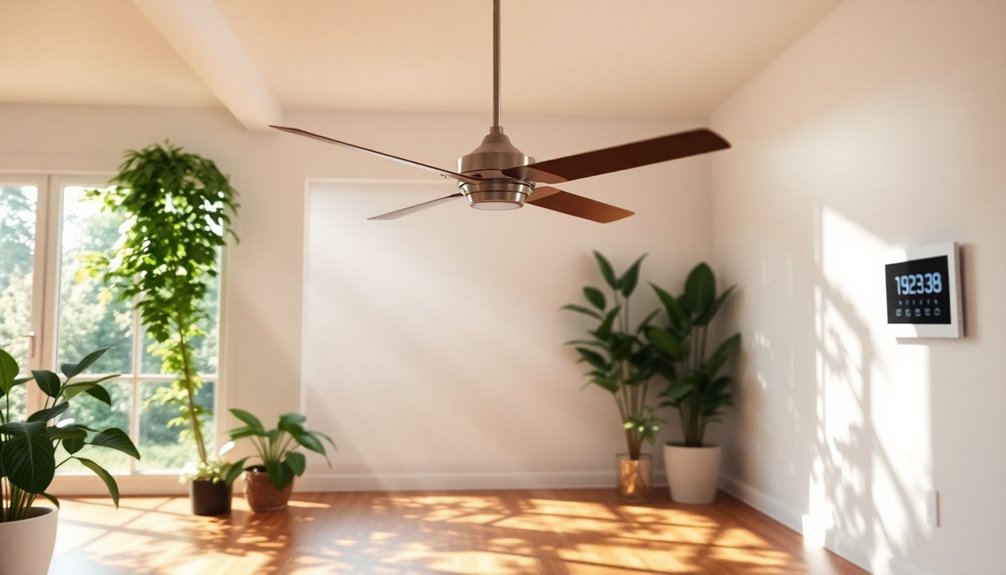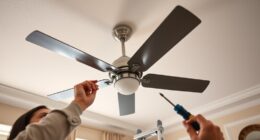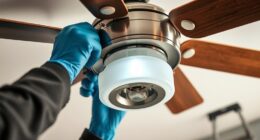Yes, a ceiling fan can help in the winter! By running it clockwise at a low speed, you push warm air down, eliminating cold spots and enhancing overall comfort. This gentle circulation allows existing warm air to reach every corner of the room, making it feel cozier without raising the thermostat. With proper use, ceiling fans can even lower your heating costs by up to 15%. Remember, they don't heat the air directly but redistributes warmth effectively. Curious about how to optimize your fan's performance for winter? There's more to explore!
Key Takeaways
- Ceiling fans improve warm air circulation, reducing energy usage by up to 15% in winter.
- Running fans clockwise at low speed redistributes warm air and eliminates cold spots.
- Proper use can lower thermostat settings by about 4°F, leading to heating cost savings.
- Ceiling fans are effective in enhancing comfort but do not directly heat a room.
- Regular maintenance and correct placement are essential for optimal performance during winter.
Benefits of Ceiling Fans in Winter

While many people think of ceiling fans as a summer staple, they can also be incredibly beneficial in winter. When you run your ceiling fans in winter mode, you'll notice a significant difference in how warm air circulates throughout your home.
By creating an updraft with a clockwise rotation, ceiling fans help redistribute that warm air, which naturally rises to the ceiling, back down into your living areas. This simple adjustment can reduce your winter energy usage by up to 15%, allowing you to save energy and lower your heating costs.
In addition to improving energy efficiency, ceiling fans enhance comfort by preventing cold spots, especially in rooms with high ceilings or poor insulation.
With better air distribution, you can even lower your thermostat settings by about 4°F without sacrificing warmth. Plus, operating your ceiling fans in winter mode can help reduce moisture buildup and condensation, promoting better indoor air quality.
Correct Fan Direction for Winter

To make the most of your ceiling fan during winter, it's essential to set it to rotate clockwise. This clockwise direction creates an updraft that pulls cold air upwards while pushing warm air down towards the floor. As a result, you'll enjoy a more comfortable space without drastically increasing your heating costs.
Running your ceiling fan on a low speed during winter maximizes the warming effects while minimizing uncomfortable drafts. By redistributing warm air that accumulates near the ceiling, you can maintain even temperatures throughout the room. Here's a quick look at the benefits of the correct fan direction:
| Fan Setting | Effect |
|---|---|
| Clockwise (Low Speed) | Pushes warm air down |
| Clockwise (High Speed) | Uncomfortable drafts |
| Counterclockwise | Circulates cold air upward |
| Power Off | No air movement, stagnant air |
Properly setting your ceiling fan can lead to energy savings of up to 15% on heating costs, making it a simple yet effective way to enhance comfort. So, take a moment to adjust your fan and enjoy the benefits of improved air movement this winter!
How to Change Fan Direction

Changing the direction of your ceiling fan for winter is a straightforward process that can greatly enhance your comfort.
To change the direction, locate the direction switch on the motor housing—this is often a simple toggle or button. If you're dealing with an older model, you might need a screwdriver or even to remove the blades to access the switch.
Once you've made the adjustment, set the ceiling fan to spin clockwise at a low speed. This creates an updraft, which helps redistribute warmer air that's risen to the ceiling, enhancing the efficiency of your heating system.
The gentle circulation of warmer air guarantees your room feels cozy without creating uncomfortable drafts.
Always refer to your fan's manual for specific instructions and troubleshooting steps.
While many rooms benefit from this adjustment, keep in mind that high ceilings may not require frequent direction changes if warm air is circulating effectively.
Energy Efficiency and Savings

Adjusting your ceiling fan for winter not only enhances comfort but also boosts energy efficiency and savings. By redistributing warm air that gathers near the ceiling, ceiling fans help reduce your heating costs by up to 15%.
You can even lower your thermostat settings by about 4°F without sacrificing comfort, leading to additional energy savings.
Using ENERGY STAR-rated ceiling fans can cut energy usage by up to 60%, so you can save money on your energy bills.
With efficient circulation of warm air, your heating system performs better, resulting in a more consistent indoor temperature and reduced energy consumption. This means you won't have to rely as much on your heating system, minimizing its workload.
As a bonus, this reduced strain can extend the lifespan of your HVAC unit, saving you from costly repairs or replacements in the long run.
User Comfort and Perception

Ceiling fans can greatly enhance user comfort during winter months, especially in rooms where cold spots are common. When you run your ceiling fan in reverse, it helps circulate warm air that tends to collect near the ceiling. This gentle air movement can considerably improve your perception of warmth, making the room feel more cozy and inviting. Additionally, using ceiling fans in conjunction with a heat pump can optimize energy efficiency and comfort levels. Energy-efficient technology in heat pumps works synergistically with ceiling fans, maximizing overall heating performance.
However, personal comfort levels vary. While many users appreciate the warmth and even temperature distribution ceiling fans provide, others might feel a chill due to increased air movement.
In high-traffic areas, ceiling fans often help maintain a consistent temperature, reducing the sensation of cold drafts that can be uncomfortable.
Your perception of energy efficiency also plays a role in how you feel about using ceiling fans in winter. If you find yourself feeling warmer at lower temperatures, you could save on heating costs while enjoying greater comfort. Additionally, using ceiling fans aligns with the importance of regular dental visits by promoting overall health and well-being through improved comfort and energy savings.
Ultimately, ceiling fans can be a valuable tool for enhancing user comfort during the colder months, especially if you're mindful of how air movement affects your personal comfort levels.
Common Misconceptions About Ceiling Fans

You might think ceiling fans warm the air directly, but they actually just help move existing warm air around.
It's also easy to assume that running a fan in an empty room is helpful, yet it won't warm the space and can make it feel colder.
Understanding these misconceptions can enhance your home's energy efficiency and comfort during the winter months.
Heat Redistribution Myths
Many homeowners misunderstand the role of ceiling fans in winter, believing they can directly heat a room or that they create uncomfortable drafts. In reality, ceiling fans don't generate heat; instead, they assist in heat redistribution. When you run your fan blades clockwise at a low speed, they create an updraft that pulls cold air upward while pushing warm air down to the floor. This process helps maintain a consistent temperature throughout the room, enhancing comfort during the heating season.
You might think that using ceiling fans in high-ceilinged rooms is pointless, but that's a myth. Proper fan operation can still circulate warm air effectively, regardless of ceiling height.
Some homeowners mistakenly believe fans need to run continuously for heating benefits, but they're most effective in occupied spaces. Running them in unoccupied rooms won't distribute heat efficiently.
Additionally, it's a misconception that ceiling fans are solely for cooling. When used correctly, they can save you up to 15% on heating costs by allowing you to lower your thermostat settings while keeping your space cozy. Furthermore, ensuring proper ventilation to prevent gas buildup is essential when utilizing heating appliances like ceiling fans in conjunction with wood stoves.
Understanding these truths can help you maximize the benefits of your ceiling fans this winter.
Energy Efficiency Misunderstandings
Understanding energy efficiency misconceptions surrounding ceiling fans is essential for homeowners looking to optimize their heating strategy. Many believe running a ceiling fan in winter will noticeably warm a room, but it simply redistributes hot air heat without changing the actual temperature.
Here's a table to clarify some common misconceptions:
| Misconception | Reality |
|---|---|
| Ceiling fans considerably warm a room | They only help redistribute existing heat |
| Running fans continuously saves energy | It can raise heating costs due to drafts |
| Ineffective in high ceilings | They can still circulate warm air effectively |
| Should run at high speeds in winter | Low speeds prevent uncomfortable drafts |
These energy efficiency misunderstandings can lead you to feel colder instead of warmer. In smaller rooms, the impact of ceiling fans is often minimal, and you might even find yourself feeling cooler when the fan is on. To truly benefit from your ceiling fan this winter, focus on using it correctly to enhance the heat distribution rather than expecting it to generate warmth on its own.
Fan Operation Confusion
Ceiling fans can be a source of confusion when it comes to their operation in winter. Many people mistakenly think that ceiling fans can actually heat a room by warming the air. In truth, they simply redistribute existing warm air, creating a more even temperature throughout the space.
A common misconception is that ceiling fans should always spin counterclockwise; however, during winter, they should run clockwise to push warm air down from the ceiling.
You might believe that running a ceiling fan all the time will lower your heating costs, but that's not the case. Fans should only be used when a room is occupied to avoid unnecessary energy consumption.
While it's often assumed that ceiling fans don't impact heating efficiency, using them correctly can lead to energy savings of up to 15% on your heating bills.
Don't overlook fan speed either; running your fan on a low setting in winter maximizes comfort without creating uncomfortable drafts.
How Ceiling Fans Enhance Heating

Using a ceiling fan in winter can considerably enhance your heating experience.
By running it in a clockwise direction, you'll redistribute warm air from the ceiling into your living space, creating a more comfortable environment.
Plus, this simple adjustment can help you save on energy costs while keeping your home cozy.
Warm Air Redistribution
When winter chill sets in, many people seek ways to stay warm without cranking up the thermostat. One effective solution is using ceiling fans. By setting your ceiling fan to rotate clockwise, you create an updraft that pulls cold air upward and pushes warm air down, enhancing the redistribution of heat throughout your room. This method is especially beneficial when using best airflow ceiling fans, as they are designed to optimize air circulation. Additionally, incorporating home security systems can provide peace of mind during the winter months when you're relying on heating solutions.
This simple adjustment helps eliminate cold spots, maintaining a more even temperature that boosts your overall comfort. With warm air circulating from the ceiling to lower levels, you'll feel cozier without needing to raise the thermostat. In fact, properly utilized ceiling fans can reduce your winter energy usage by up to 15%. This means you can lower your thermostat settings while still enjoying a comfortable living space.
Furthermore, the gentle circulation of warm air helps eliminate drafts, making your home feel even warmer. By assisting your heating system in distributing warm air, ceiling fans can also reduce the workload on your furnace, contributing to energy savings and extending the lifespan of your HVAC system. Additionally, integrating ceiling fans with smart technology integration can enhance their efficiency and provide more precise control over your home's heating. Regular maintenance of your heating system, such as filter replacement, can further improve overall efficiency and performance.
Embracing ceiling fans in winter is a smart move for both comfort and efficiency.
Energy Efficiency Benefits
Many homeowners overlook the remarkable energy efficiency benefits that ceiling fans can provide during the winter months. By running your ceiling fan on a low speed in a clockwise direction, you create an updraft that pushes warm air down from the ceiling, enhancing comfort without raising heating costs.
This simple adjustment allows you to lower your thermostat settings by about 4°F, which can lead to significant energy savings.
Utilizing an ENERGY STAR-rated ceiling fan can further amplify these savings, as these models can reduce energy usage by up to 60%. With the right ceiling fan, you can save up to 15% on heating costs by redistributing warm air more effectively throughout your space.
This not only keeps you warm but also reduces the workload on your heating system, potentially extending its lifespan.
Incorporating ceiling fans into your winter heating strategy is a cost-effective way to improve energy efficiency. You'll enjoy a cozy home while reducing your energy consumption, ultimately benefiting both your wallet and the environment.
Optimal Fan Direction
To maximize the heating benefits of your ceiling fan, it's crucial to confirm it's rotating in the correct direction. During winter, you want your ceiling fan to spin clockwise. This ideal fan direction creates an updraft that pulls cold air upwards while pushing warm air down towards your living space, enhancing overall comfort.
Using your fan at a low speed guarantees that warm air, which naturally rises, gets redistributed effectively. This simple adjustment can help maintain even temperatures, preventing cold spots throughout the room. In fact, properly adjusted ceiling fans can reduce heating costs by up to 15%, allowing you to lower your thermostat without sacrificing comfort.
To help you understand the benefits, here's a quick overview:
| Fan Setting | Direction | Benefit |
|---|---|---|
| Winter (Low) | Clockwise | Circulates warm air down |
| Winter (High) | Clockwise | Not recommended |
| Summer (Low) | Counterclockwise | Creates a cooling breeze |
| Summer (High) | Counterclockwise | Enhances airflow |
| Reverse Switch | N/A | Adjusts fan direction |
Make sure to utilize the reverse switch on your ceiling fan for ideal airflow during colder months!
Additional Winter Uses for Ceiling Fans

Harnessing the benefits of ceiling fans in winter can greatly enhance your home's comfort and efficiency. When you use a ceiling fan, you can effectively move warm air that rises to the ceiling back down into the living space. This simple action boosts heating efficiency and creates a consistent indoor temperature, preventing those pesky cold spots.
Here are some additional winter uses for ceiling fans:
- Reduce Condensation: Fans help minimize moisture buildup in damp areas, improving indoor air quality.
- Energy Savings: Utilizing ceiling fans can lead to energy savings of up to 15%, as they lighten the workload on your heating system.
- Extend Furnace Life: By decreasing the frequency of operation, ceiling fans can prolong your furnace's lifespan, reducing wear and tear.
Frequently Asked Questions
Is There Any Point in Using a Ceiling Fan in Winter?
You might wonder if there's any point in using a ceiling fan in winter.
Absolutely! Running a ceiling fan can help distribute warm air more evenly throughout your space, making it cozier.
By setting it to run clockwise at a low speed, you create an updraft that pushes warm air down, reducing cold spots.
This can lower your heating costs and make your home more comfortable, all while prolonging your heating system's lifespan.
Can a Ceiling Fan Warm a Room?
Yes, a ceiling fan can warm a room. By running it in a clockwise direction at a low speed, you create an updraft that pushes warm air down from the ceiling, enhancing comfort.
This helps eliminate cold spots and maintains even temperatures throughout the space. Using a ceiling fan not only makes your room cozier but can also lead to energy savings, allowing you to lower your thermostat without sacrificing warmth.
Is It Good to Leave Your Ceiling Fan on All the Time?
Leaving your ceiling fan on all the time isn't the best idea.
If the room's unoccupied, you're just wasting energy since the fan doesn't change the room temperature.
When you're present, running it on a low speed can help create a more comfortable environment by redistributing air.
Just remember to turn it off when you leave to avoid unnecessary costs and conserve energy.
Smart usage is key for efficiency!
What Direction Do I Rub My Ceiling Fan in the Winter?
You might think it doesn't matter which way your ceiling fan spins, but it actually does!
In winter, you should set your fan to rotate clockwise. This creates an updraft, pushing warm air down into your living space.
It'll help keep your home cozy while preventing cold spots. Just switch it to a low speed, and you'll enjoy the warmth without drafts.
Plus, you could save on heating costs—now that's a win!
Conclusion
As winter blankets your home in a cozy chill, don't overlook your ceiling fan. With a simple flick of a switch, you can create a gentle upward draft, pushing warm air down like a soft, warm hug. This not only boosts your comfort but also lightens the load on your heating bill. Embrace the dance of warm air swirling around your room, and let your ceiling fan be the unsung hero of your winter haven.









